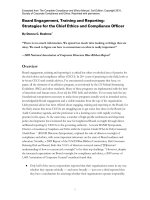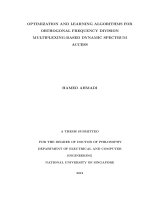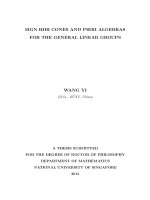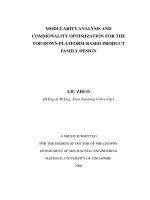Modularity analysis and commonality optimization for the top down platform based product family design
Bạn đang xem bản rút gọn của tài liệu. Xem và tải ngay bản đầy đủ của tài liệu tại đây (1.35 MB, 155 trang )
MODULARITY ANALYSIS AND
COMMONALITY OPTIMIZATION FOR THE
TOP-DOWN PLATFORM-BASED PRODUCT
FAMILY DESIGN
LIU ZHUO
(B.Eng & M.Eng, Xian Jiaotong University)
A THESIS SUBMITTED
FOR THE DEGREE OF DOCTOR OF PHILOSOPHY
DEPARTMENT OF MECHACNIAL ENGINEERING
NATIONAL UNIVERSITY OF SINGAPORE
2008
ACKNOWLEDGEMENTS
Firstly, I would like to express my most sincere gratitude to my advisors, Professor
Wong Yoke San and Associate Professor Lee Kim Seng, for motivating and guiding
me academically and professionally in this project over the past years. The breadth
and depth of their knowledge, timely feedback, constructive insight, and constant
encouragement have helped me to complete my research and will continue to benefit
my future work.
I would like to thank Dr. Lu Cong, Dr. Maria Low Leng Hwa, Mr. Li Min, Mr. Fan
Li Qing, and Miss Zhu Ya Da for their help and advice during my Ph.D research. And
I would also like to thank Mr. Zhu Shi Yan for his kind assistance in the case study.
In addition, I would like to thank Associate Professor Zhang Yun Feng and
Associate Professor Loh Han Tong, for their invaluable comments and suggestions on
my research during my Ph.D qualification exam.
I would also like to thank National University of Singapore for offering me
research scholarship. The first-class research facilities, abundant professional resource,
and beautiful campus environment will leave me a strong impression for ever.
Finally, I would like to devote this thesis to my family and girlfriend for their
self-giving love and constant support.
i
Table of Contents
Acknowledgements і
Table of Contents ii
Summary vii
List of Figures ix
List of Tables xi
Chapter 1 Introduction 1
1.1 Background 1
1.2 Platform-based Product Family Design 2
1.2.1 Product Architecture 3
1.2.2 Platform Strategies 4
1.2.3 Modular and Scalable Product Platform 5
1.3 Research objectives 6
1.4 Organization of thesis 7
Chapter 2 Literature Review 9
2.1 Overview 9
2.2 Product Family Architecture (PFA) 11
ii
2.2.1 Product Architecture and Modularity 11
2.2.2 Architecture for Product Family 12
2.3 Platform-based Product Family Design 14
2.3.1 Platform Implications 14
2.3.2 Types of Platform Design 16
2.3.3 Commonality Metrics for Product Family Design ………… ……19
2.4 Scalable Platform and Product Family Design 19
2.4.1 Platform Configuration and Decision 21
2.4.2 Optimization Stages and Techniques 23
2.5 Summary 26
Chapter 3 A Framework of the Proactive Platform-based Product
Family Design
28
3.1 Introduction 28
3.2 A Framework for Top-down Product Family Design 31
3.2.1 System-level Design: Modularization of PFA 32
3.2.2 Detailed Design: Commonality Optimization for Scalable Product
Family Design 33
3.3 Problem Boundary 34
Chapter 4 Modularization of Conceptual PFA 36
4.1 Introduction 36
iii
4.2 Variety Analysis 38
4.3 Integrated Method to Modularize Conceptual PFA 42
4.3.1 Product Family Planning 42
4.3.2 Function based Product Modularization 44
4.3.3 Variety Analysis 46
4.3.4 Product Portfolio Architecture 50
4.4 Case Study 51
4.4.1 A Product Family of Cordless Drills/Drivers 52
4.4.2 Functional Modularization 53
4.4.3 Attribute-Module Matrix and Variety Analysis 56
4.4.4 Instance Derivation and Product Portfolio Architecture 60
4.5 Summary 62
Chapter 5 Manufacturing-biased Platform Decision and Product
Family Design
64
5.1 Introduction 64
5.2 Multi-Platforming Configuration 65
5.3 Manufacturing-biased Commonality Index 67
5.4 Systematic Scalable Product Family Design 71
5.4.1 Individual Design 72
5.4.2 Platform Decision 74
5.4.3 Aggregation of Multiple objectives 78
iv
5.5 Discussion 79
5.6 Summary 80
Chapter 6 Product Family Design Using a Modified GA-based
Optimizer
82
6.1 Introduction 82
6.2 Evolutionary Weight Aggregation for Multi-objective Optimization 82
6.2.1 Non-dominated Solutions 82
6.2.2 Dynamic Weighted Aggregation 85
6.3 GA-based Optimization for Product Family Design 86
6.3.1 Generic Coding 86
6.3.2 Generic Operator: Crossover and Mutation 88
6.3.3 Fitness Evaluation 90
6.3.4 Selection 92
6.3.4 Overall Workflow 92
6.4 Summary 93
Chapter 7 Case Study: A Family of Transmission Module Design 95
7.1 Introduction 95
7.2 Individual Design 98
7.3 Platform Decision 102
7.4 Aggregation of Multiple Objectives 104
v
7.5 Family Design Using GA 105
7.6 Verification and Discussion 114
7.7 Summary 118
Chapter 8 Conclusions and Future Work 120
8.1 Summary 120
8.2 Contribution 121
8.2.1 Modularity Analysis for Variety Generation 121
8.2.2 Manufacturing-biased Platform Decision 122
8.2.3 Effective GA-based Optimizer for Product Family Design 122
8.3 Future Work 123
8.3.1 Interface Design for PFA 123
8.3.2 Integration of Market Research 124
8.3.3 Improvement of Computational Efficiency 124
References 126
Appendix 137
Publications 143
vi
Summary
With highly fragmented market and increased competition, platform-based product
family design has been recognized as an effective method to construct a product line
that satisfies diverse customer’s demands while aiming to keep design and production
cost- and time- effective. Recognizing the essentiality of modularity and commonality
in the platform development, this thesis presents a systematic framework to
implement top-down platform and product family development, which aims to
achieve modularity for variety management at system-level design stage and
rationalize commonality configuration for module instantiation at detailed design
stage
Rather than just identifying module boundary and interface in the product
architecture, the development of product family architecture (PFA) in this research
incorporates customized requirements and constructs a flexible and robust product
architecture to accommodate variations. Towards this, the implication of PFA can be
viewed as a conceptual structure with three interrelated elements: module, variant,
and coupling interface. Variants in term of different customer requirements act as the
external drivers of architectural variation and meanwhile variation is propagated
within the product architecture through module interaction. Based on this principle, a
step-by-step method is proposed to systematically modularize the PFA, involving
functional modularization and variety analysis. The generated product portfolio
architecture provides an engineering insight to manage variety in terms of functional
vii
module configuration and also prepares the targets for further design.
To achieve economy of scales by increasing commonality during module
instantiation, a scalable platform design method is adopted at the detailed design stage.
Its success often relies on properly resolving the inherent tradeoff between
commonality across the family and performance loss compared to individually
tailored design. In this research, we propose a multi-platform product family (MPPF)
approach to accomplish such balance. In the light of the basic premise that increased
commonality enhances manufacturing efficiency, we present an effective platform
decision strategy to quantify family design configuration using a commonality index.
The proposed strategy takes into account the basic platforming elements and expected
sharing degree by coupling design varieties with production variation. Meanwhile,
unlike many existing methods that assume a single given platform configuration, the
proposed method addresses the multi-platforming configuration across the family, and
can generate alternative product family solutions with different levels of commonality.
A modified genetic algorithm is developed to solve the aggregated multi-objective
optimization using an efficient and dynamic weighted aggregation method.
In the case studies, a family of power tool design is used to demonstrate the
proposed method at system-level and detailed design stages.
viii
List of Figures
Figure 1.1 Industrial examples of platform-based product families 3
Figure 1.2 Illustrations of bottom-up platform A and top-down platform B 5
Figure 2.1 An overview of platform-based product family design …………… 9
Figure 2.2 Three platform leveraging strategies 16
Figure 2.3 Research scope of scalable product family design 21
Figure 3.1 Modularity and commonality for platform development 29
Figure 3.2 Platforming principles for modularity and commonality 30
Figure 3.3 A proposed framework for product family design 32
Figure 4.1 Three elements of product family architecture 37
Figure 4.2 Illustration of Variety Index 40
Figure 4.3 Three steps for modularizing the conceptual PFA 42
Figure 4.4 Illustration of functional modeling 45
Figure 4.5 Engineering view of product portfolio architecture 51
Figure 4.6 Functional modeling of power tool family 55
Figure 4.7 Two perspectives of Attribute-Module relation 56
Figure 4.8 VI versus NRE versus feasibility of over-design 59
Figure 5.1 Cost contribution of different varieties 65
Figure 5.2 Single-platform and Multi-platforming configuration 67
Figure 5.3 Platform decision affected by manufacturing consideration 69
Figure 5.4 A linear relation between CI and the number of instances 71
ix
Figure 5.5 Framework of systematic product family design 72
Figure 5.6 The principle of activity-based costing 75
Figure 5.7 Illustration of manufacturing-biased platform decision 77
Figure 6.1 Multi-objective optimization for family design 83
Figure 6.2 Dynamic weighted aggregation toward Pareto front 86
Figure 6.3 Example of coding scheme for product family 86
Figure 6.4 Example of generic representation for individual design 87
Figure 6.5 Illustration of two-point crossover 88
Figure 6.6 Illustration of two mutation operators 89
Figure 6.7 Overall procedure of GA-based optimization 93
Figure 7.1 Explored structure of planetary gear train 96
Figure 7.2 Simplified design model for planetary gear train 99
Figure 7.3 Running samples of individual design 100
Figure 7.4 A scheme of influence of platforming elements on processes 102
Figure 7.5 Preference functions for performance normalization 105
Figure 7.6 Running sample of product family design 107
Figure 7.7 Plotted family solutions with varying level of commonality 108
Figure 7.8 Performance deviation in layer 3 with respect to commonality,
number of variable instances, and number of part instances 112
Figure 7.9 Mass comparison among the four family solutions 115
Figure 7.10 Comparison of the average production cost by four methods with
varying volume 118
x
xi
List of Tables
Table 4.1 Comparison of various modularization processes 44
Table 4.2 Specification implementation between modules and attributes 48
Table 4.3 VI rating system 47
Table 4.4 Collection of product family specifications 53
Table 4.5 Modules of cordless drill family 54
Table 4.6 Attribute-Module Matrix and Variety Index 58
Table 4.7 Module-component categorization of cordless drill 59
Table 4.8 Engineering specification for module instances 61
Table 7.1 Performance criteria with target and preference 98
Table 7.2 Information of design variables 98
Table 7.3 Results of individual design (benchmark) 101
Table 7.4 ESD for the basic platforming elements 104
Table 7.5 Specification of multi-platforming family design 110
Table 7.6 Performance comparison of non-platform and platform designs 113
Table 7.7 Results of families with pre-specified single platforms 113
Table 7.8 Cost comparison among individual and family designs 116
Chapter 1 Introduction
1
Chapter 1 Introduction
1.1 Background
Today’s turbulent market compels enterprises to redefine the paradigm of doing
business. Customers express their preferences not only for product quality, but also
for variety and personalization. Therefore, identification and fulfillment of
customer’s individual needs become imperatives to maintain competitiveness by
integrating customer requirements in the value creation. Meanwhile, increasingly
competitive intensity - arising in particular from unceasing technical renovation,
globalization and convergence of industries – rapidly shortens the product life cycle
from launch to disposal, and thus compels companies to reduce delivery time to
market and expand product variety (Anderson, 1997).
In response to this customer-driven market, most manufacturers take advantage of
the strategy of mass customization or mass personalization to increase customer
satisfaction with a high variety of offerings. Contrary to the traditional one-at-a-time
design, mass customization aims to deliver a variety of products and services
simultaneously for various market niches without sacrificing efficiency,
effectiveness and low costs. With effective planning and management of product
development, mass customization enables manufacturers to quickly respond to
market fluctuation and grasp latent opportunities. In addition, the emergence of
e-business also relies on and facilitates the successful implementation of mass
customization to maximize the customers’ satisfaction through expansion of their
product lines.
Chapter 1 Introduction
2
1.2 Platform-based Product Family Design
Currently, a popular strategy to effectively deliver a stream of products is to
design multiple products as a product family, within which components, processes
and technologies are effectively shared among the family members via a product
platform. Then the individual product can be derived from the platform in an
effectively planned manner to meet various requirements, which may come from
space context as spatial variety and time context as generational variety (Martin and
Ishii, 2002). Spatial variety refers to the variety that the company offers the market
at a point in time, in terms of various combinations of features or cost segmentations.
The generational variety involves the evolutional changes of a product family over
time. Both spatial and generational varieties are very important and always
synchronously implemented for product development
Clusters of examples from different industries have been reported that take
advantage of platform-based product family development to cater for spatial and
generational requirements, as shown with examples illustrated in Figure 1.1. Sony
has used three platforms to successfully create hundreds of different portable stereo
models in its Walkman line since 1980’s (Sanderson and Uzumeri, 1997). This
variety-intensive development pattern helps Sony to dominate worldwide market for
more than a decade despite fierce competitions from other contenders. Black &
Decker, the world’s largest producer of power tools, built its product line around
motor platform to meet different applications (Meyer and Lehnerd, 1997). Kodak is
reported to win the market share of single-use cameras back from Fuji by effectively
planning platform development (Robertson and Ulrich, 1998). Hewlett Packard
successfully develops a series of printers and gains platform benefits by postponing
the point of differentiation (Feitzinger and Lee, 1997). In the automotive industry,
Chapter 1 Introduction
3
Volkswagen has shared its platform across several brands, such as Audi, Seat, Skoda,
as well as Volkswagen (Simpson, 2004b&2006). These successful examples prove
the feasibility and superiority of platform-based strategies to ensure companies’
competitiveness by creating a consecutive line of product offerings. While adopting
platform thinking in the product development, these companies present different
platform definitions and strategies in their context due to the spectrum covered in
the platform planning and development, as well as the nature of targeted products
and marketplace (Halman et al., 2003).
Figure 1.1: Industrial examples of platform-based product families
1.2.1 Product Architecture
T
o efficiently customize products for individual customers and help understand
the complexity of product design at the conceptual design stage, the definition of
product architecture is brought forward to decompose the complex system into
subsystems or chunks. Ulrich (1995) defines product architecture as a scheme by
which the function of a product is allocated to physical components. Modularity is
Chapter 1 Introduction
4
referred to as the most important characteristics of product architecture and
accordingly there are two types of architecture: modular and integral. A modular
product architecture is one-to-one or many-to-one mapping relationship between
functional elements and physical structure, and can easily create product variants by
combinations of functional blocks, such as personal computers; otherwise, integral
architecture is characterized by a complex or coupled mapping of functional
elements to physical structures and it can acquire advantages of performance due to
elimination of interfaces and integration of multi-functions into fewer parts
(Gonzalez-Zugasti, 2000). While integral architectures aim to increase product
performance and reduce cost, modular architectures are driven by variety, product
change, and standardization (Cutherell, 1996).
Modularity or modular design enables firms to achieve many strategic advantages
and has become a major focus for product realization (Baldwin and Clark, 2000;
Jose and Tollenaere, 2005; Jiao et al., 2007d). In terms of functional modularity,
companies can easily create the variety of product offerings by changing the
arrangement and adding new functional modules (Ulrich and Eppinger, 2000).
Meanwhile, modular design provides a flexible and loosely coupled product
structure and thus allows for reuse of the existing design with minor changes and
reduced efforts for product upgrade (Sand et al., 2002). Additionally, modularity can
help designers to decompose the overall design into smaller tasks and achieve
parallel product development to shorten time-to-market (Gershenson et al., 2003).
1.2.2 Platform Strategies
Although various approaches to product family design are developed by many
companies or researches to deliver a series of variants targeted to different market
niches, there is still a strategic difference among them depending on whether or not
Chapter 1 Introduction
5
the companies take proactive steps to mange the platform development and variety
generation (Simpson et al., 2001a). One is called the top-down approach wherein a
company strategically develops a family of products based on a carefully tailed
product platform, as illustrated by platform B in Figure 1.2 (Simpson, 2004b; Alizon
et al., 2007). Some industrial companies (e.g. Sony, Kodak) are reported to introduce
a derivative based series on a product platform by carefully planning and managing
the platform design (Sanderson and Uzumeri, 1997; Robertson and Ulrich, 1998).
Another approach is the bottom-up approach or reactive redesign, wherein a
company redesigns or consolidates a group of distinct products to improve
economies of scale by standardizing the components, as illustrated by platform A in
Figure 1.2 (Simpson, 2004b; Alizon et al., 2007). For instance, Black & Decker is
reported to benefit from component standardization by redesigning universal motor
(Meyer and Lehnerd, 1997). Whether it is top-down or bottom-up approach,
platform-based product development provides a lot of benefits, including reduced
development complexity and cost, reduced production cost, improved response to
market, and reduced risk for new product development (Meyer and Lehnerd, 1997;
Simpson, 2004b&2006;).
Figure 1.2: Illustrations of bottom-up platform A and top-down platform B
1.2.3 Modular and Scalable Product Platform
Chapter 1 Introduction
6
Depending on the hierarchical level in the product architecture, there are two
different types of platform: modular and scalable platform. The former platform is
through the development of modular product architecture and product family
members are instantiated by adding, substituting, and/or removing one or more
functional modules from the platform (Simpson, 2004b). For example, Sony builds
all of its Walkmans around key modules and platforms by using the principle of
modular design to deliver more than 250 models (Sanderson and Uzumeri, 1997).
The scalable platform is to “stretch” or “shrink” the platform in one or more
dimensions to satisfy a variety of market niches (Simpson et al., 2001a). Unlike
module-based product platforms, scale-based platform focuses on the commonality
issue at the lower level of product structure and provides an effective means to
satisfy a variety of performance requirements by scaling one or more variables. For
example, Simpson et al. (2001a) develop a family of electrical motors based on
scaling optimization along various dimensions to produce a range of power outputs
for diverse applications.
1.3 Research Objectives
Recognizing the essentiality of modularity and commonality in platform-based
product development, this research aims to develop a top-down methodology for
proactive product family design to aid in product differentiation for various market
requirements and thereby facilitate the effective implementation of mass
customization. More specifically, the necessary tasks in this study are identified as
follows.
The first task is to achieve modularity at the system-level design stage for variety
generation and management. By extending the extent of the traditional product
Chapter 1 Introduction
7
architecture, the product family architecture is approached as a conceptual
structure with three important interrelated elements: module, variant and coupling
interface. An integrated modularization approach is developed to translate the
variety of requirements into a dynamic configuration of the conceptual product
family architecture, involving variety analysis, functional modularization, and
generation of product portfolio architecture.
The second task is to tackle the commonality issue as a multi-objective
optimization problem based on an effective platform decision. To enhance
commonality at detailed module instantiation stage while maintaining certain
economical efficiency, a manufacturing-biased platform decision strategy for
scalable product family design is presented to coordinate design variety with
production variation so that the family members can be derived in expected
economical manner.
The third task is to develop an effective optimizer to solve the inherent trade-off
between performance and commonality. A modified genetic algorithm is
developed to explore the alternative solutions with varying level of commonality
based a dynamic weighted aggregation method.
The results of this study as a whole would serve as a guide tool to approach the
platform-based product family design. The proposed methodology does not intend to
replace the existing development process but assist in handling multi-product
development while exploiting opportunities to achieve economy of scales with
effective planning and optimization.
1.4 Organization of this thesis
The thesis is organized as follows.
Chapter 1 Introduction
8
Chapter 2 reviews the research work related to platform-based family design, as
well as the gaps current approaches reported in the literature, and motivation for this
research.
Chapter 3 presents the framework for platform-based family design in this thesis,
which is viewed as a top-down development paradigm to achieve modularity at the
system-level design stage and commonality at the detailed design stage.
Chapter 4 focuses on system-level modularization of product family architectures
for variety generation based on functional modeling, and also develops a
quantitative method to analyze the variety effect of customization on modules. A
case study of power tool family design is used to demonstrate the proposed method.
Chapter 5 introduces a manufacturing-biased platform decision for detailed
module instantiation and commonality optimization at the detailed design stage. The
proposed platform strategy attempts to quantify family design configuration using a
commonality index that couples design varieties with production variation. Then the
measured commonality is incorporated into the family design model
Chapter 6 presents the development of a modified genetic algorithm for
optimizing multi-objective product family design using dynamic weighted
aggregation method.
Chapter 7 demonstrates the proposed approaches to scalable product family
design and optimization on a case study of designing a family of transmission
module.
Chapter 8 gives the conclusions, contributions and recommendations.
Chapter 2 Literature Review
9
Chapter 2 Literature Review
2.1 Overview
An increasingly large but diverse body of research on platform-based product
family design has been made over the last decade to address various aspects of
product fulfillment, involving marketing, design, manufacturing, management and
so on. The variety of methodologies stems from not only the particular aspects of
family design addressed, but also the inherent nature of their case studies and
assumptions made. Thus it is very difficult to capture the rationale behind the
seemingly isolated issues without a conceptual structure and overall logical
organization. Fortunately, the adoption of multi-domain views along the entire
spectrum of product realization (Suh, 1990&2001) enables platform-based family
design to be tackled from several coherent perspectives, namely customer,
functional, physical, and process domains as shown in Figure 2.1 (Jiao et al., 2007d).
Although the platform-based approaches proposed in the literature share the same
principle of commonalization, the platform in each domain exhibits different
implication within the context.
Figure 2.1: An overview of platform-based product family design
Chapter 2 Literature Review
10
The customer domains can be described with a set of diverse customer needs
(CNs), which represent different functions and performance characteristics towards
the target product. Accordingly, the task is to plan the right product variety to the
right market segment and then trigger the downstream stage of product design in a
cascading manner (Jiao et al., 2007d). In the functional domain, the CNs are first
translated into functional requirements (FRs) in terms of available engineering
technologies. Then a conceptual architecture for product family can be developed to
assist in the variety generation and management. Subsequently, the detailed family
solutions are generated in the physical domain by mapping FRs to design parameters
(DPs) based on the effective platform basis. This stage not only involves decisions
regarding family design and optimization to minimize the loss of performance or
distinctiveness due to the platforming effect, but also maintain the manufacturing
efficiency by coupling design varieties with product variation. At the back-end, the
mapping from DPs to process variables (PVs) generate production planning to
construct a standard process platform or infrastructure, around which variant
processes can be derived to realize the production of the product family (Jiao and
Tseng, 2004).
As a whole, the implementation of mass customization begins with the front-end
customer domain and then spreads to the latter design stage in terms of various
functional/physical entities, and then to the production stage in terms of re-allocation
of processes and resources. To maintain the whole value chain in a cost- and time-
effective manner, various platform-based approaches in each domain are developed
to capture and utilize commonality for variety generation.
Chapter 2 Literature Review
11
2.2 Product Family Architecture
2.2.1 Product Architecture and Modularity
The development of a product architecture, assigning forms to functional
elements, is a critical phase at the conceptual design stage because the choice
generated will strongly influence the product performance in several aspects,
including later detailed design, manufacturability, product variety, and so on. Ulrich
and Eppinger (1995) define a product architecture as consisting of three elements: (1)
the arrangement of functional elements (2) the mapping relation between functions
and physical elements, and (3) the specification of the interfaces among interacting
physical components.
Most research in this field focuses on identification and representation of modular
architecture using decomposition and clustering techniques. Pimmler and Eppinger
(1994) decompose the product into elements and then cluster them into chunks by
considering the generic interaction types: spatial, energy, information and material.
Kusiak and Huang (1996) develop the modular product with the consideration of
performance and cost, and later they develop a decomposition approach to solve
modularity problem based a matrix representation (Huang and Kusiak, 1998). Gu
and Sosale (1999) identify product modules from various life cycle engineering
perspectives such as assembly, maintenance and recycling. Van Wie et al. (2001)
address architectural issues from interface perspective and aims to reduce assembly
cost by investigating component interactions. Later, he and co-authors (2003)
present an architecture representation to link functional design and embodiment
design.
Functional modeling or diagram in terms of available engineering technologies
Chapter 2 Literature Review
12
provides another effective means to modularize product architecture at the
conceptual design stage. Stone et al. (2000b) combine functional model and a
heuristic method to assist in identifying modules. Later, they propose a quantitative
functional model to develop architecture with consideration of customer need ratings
(Stone et al., 2000c). Dahmus et al., (2001) also adopt functional modeling method
to modular product architecture for multi-product design. By incorporating
functional structure, Holtta et al. (2005) present a method to measure redesign effort
based on analysis of functional flows: material, energy, and information.
Additionally, modularity has been well studied from many perspectives (Fixson,
2003; Gershenson et al., 2003&2004). Mikkola and Oliver (2003) introduces a
mathematical modularization function to assess the degree of modularity in a given
product architecture. Kusiak (2002) investigates the integration aspects of
modularity of products, processes and resources. Sosa et al., (2000) analyze the
difference in the way modular and integrative design teams handle interface using
design structure matrix (DSM).
2.2.2 Architecture for Product Family
The emergence of product family design to meet customized requirements
imposes new challenges to define product architecture. As Fujita and Yoshida (2004)
point out, the most important difference between the architecture of a product family
and that of a single product is the simultaneous handling of multiple products. Thus,
the concept and implication of product architecture have to be extended to manage
the complexity of product family. Du et al. (2001) view a product family
architecture (PFA) as the logical organization of a product family with a generic
product structure. Then tailored product variants can be generated with several
generic mechanism (e.g. module swapping, scaling). By capturing the functionally
Chapter 2 Literature Review
13
common and unique structures, Dahmus et al. (2001) develop a conceptual method
to architecture the product family.
PFA has been studied from different perspectives along the product life cycle.
Erens and Verhulst (1997) assert that the development of a product family requires
the definition of product architecture in three domains: function, technological
realization, and physical realization. The multi-view of PFA development is also
supported by Jiao and Tseng (1999&2000), who present a method to rationalize
product family development for mass customization from three aspects of functional,
technical and physical views. Additionally, Du et al. (2001) investigate some
fundamental issues regarding the architecture of a product family from both sales
and engineering perspective. Muffatto and Roveda (2002) also study the multiple
aspects of product architecture including functions, requirements, technological
solutions, product concepts, product strategies and platforms. Serving multiple
managerial purposes, Fixson (2005) investigates the multi-dimensional architecture
issues, involving product development, process and supply chain design.
As a whole, the operation of modularity analysis at different development stage is
the strategic result of a search for potential common technical solutions. The earlier
modularization process provides more freedom to define architectural content, and
allocates function-component mapping relationship. Function-based module
definitions can explore conceptual product architecture and gain an early insight into
common and unique functionality (Stone et al., 2000a&2000b; Dahmus et al, 2001).
Such functional modularization relaxes the constraint of the pre-definition of
sub-module level components and offers a fundamental approach for proactive
platform development. Assuming the basic physical element as fixed, physical
modularization generates the modular product architecture by re-arranging these









